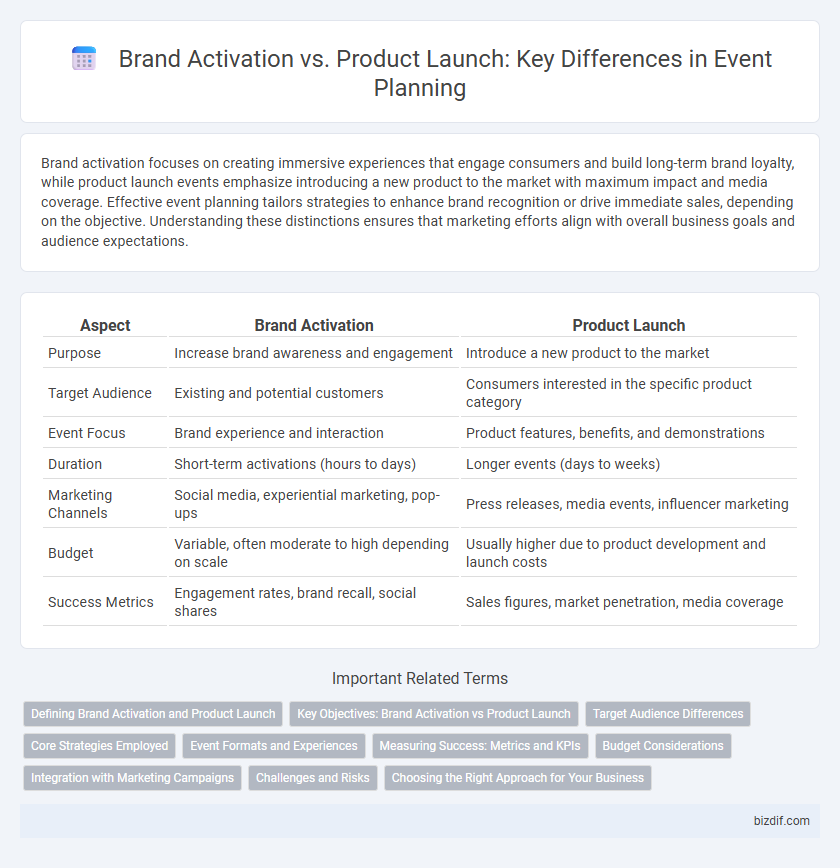Brand activation focuses on creating immersive experiences that engage consumers and build long-term brand loyalty, while product launch events emphasize introducing a new product to the market with maximum impact and media coverage. Effective event planning tailors strategies to enhance brand recognition or drive immediate sales, depending on the objective. Understanding these distinctions ensures that marketing efforts align with overall business goals and audience expectations.
Table of Comparison
| Aspect | Brand Activation | Product Launch |
|---|---|---|
| Purpose | Increase brand awareness and engagement | Introduce a new product to the market |
| Target Audience | Existing and potential customers | Consumers interested in the specific product category |
| Event Focus | Brand experience and interaction | Product features, benefits, and demonstrations |
| Duration | Short-term activations (hours to days) | Longer events (days to weeks) |
| Marketing Channels | Social media, experiential marketing, pop-ups | Press releases, media events, influencer marketing |
| Budget | Variable, often moderate to high depending on scale | Usually higher due to product development and launch costs |
| Success Metrics | Engagement rates, brand recall, social shares | Sales figures, market penetration, media coverage |
Defining Brand Activation and Product Launch
Brand activation refers to marketing efforts designed to create direct engagement and interaction between a brand and its target audience, fostering awareness and loyalty through experiential campaigns. A product launch is a strategic event focused on introducing a new product to the market, highlighting its features, benefits, and availability to drive initial sales and consumer interest. Both activities are essential components of event planning, each serving distinct objectives in building brand presence and market entry.
Key Objectives: Brand Activation vs Product Launch
Brand activation focuses on creating meaningful consumer interactions to increase brand awareness, loyalty, and engagement through experiential marketing and immersive campaigns. Product launch aims to introduce a new product to the market, emphasizing driving sales, generating buzz, and educating potential customers about features and benefits. Both prioritize strategic messaging but differ in objectives: brand activation enhances overall brand perception, while product launch targets immediate market adoption and revenue growth.
Target Audience Differences
Brand activation targets broad audiences to build long-term emotional connections and increase brand loyalty through experiential campaigns, focusing on brand awareness and engagement. Product launch events concentrate on potential customers and industry influencers to drive immediate interest, showcase specific product features, and generate early sales momentum. Understanding these target audience differences helps tailor messaging and event design for maximum impact.
Core Strategies Employed
Brand activation centers on creating immersive experiences that boost consumer engagement and emotional connection through interactive events and multi-sensory campaigns. Product launch strategies emphasize targeted communication, unveiling key features and benefits via demonstrations, media coverage, and influencer partnerships to maximize market penetration. Both approaches utilize data-driven audience segmentation and tailored messaging to optimize reach and impact during event execution.
Event Formats and Experiences
Brand activation events focus on creating immersive, interactive experiences that build long-term consumer engagement through sensory elements, storytelling, and participatory activities. Product launches prioritize showcasing new products with high-impact presentations, demonstrations, and media coverage to generate immediate awareness and sales. Both formats leverage experiential marketing tactics but differ in goal orientation--brand activations emphasize emotional connection while product launches highlight product features and direct consumer engagement.
Measuring Success: Metrics and KPIs
Brand activation success is measured through metrics such as brand awareness uplift, social media engagement rates, and consumer sentiment analysis, reflecting deeper emotional connections with the audience. Product launch effectiveness is evaluated using KPIs like sales volume, market penetration rate, and customer acquisition cost, indicating direct market impact and revenue generation. Tracking event attendance, post-event surveys, and conversion rates helps optimize both brand activation and product launch strategies for maximum ROI.
Budget Considerations
Brand activation campaigns generally require ongoing investment in customer engagement activities, making them more budget-flexible but potentially higher in cumulative spend. Product launches often demand a concentrated budget allocation for a single, high-impact event, including costs for venue, marketing collateral, and media outreach. Careful budget planning prioritizes ROI by balancing the sustained spend of brand activations with the upfront intensity of product launch expenses.
Integration with Marketing Campaigns
Brand activation seamlessly integrates with broader marketing campaigns by creating immersive experiences that strengthen brand recall and customer engagement across multiple channels. Product launches focus on introducing new items, emphasizing features and benefits, often aligned with targeted advertising and public relations efforts to maximize initial market impact. Both strategies rely on coordinated messaging and data-driven insights to enhance visibility and drive conversion within the marketing ecosystem.
Challenges and Risks
Brand activation events often face challenges in maintaining consistent consumer engagement and measuring direct impact on brand perception, while product launches encounter risks related to timing, production delays, and market readiness. Both event types require meticulous coordination to manage logistical complexities and anticipate audience reception, yet product launches bear higher stakes due to potential reputational damage from product flaws or unmet expectations. Effective risk mitigation includes thorough market research, contingency planning, and real-time monitoring to adapt strategies and ensure successful outcomes.
Choosing the Right Approach for Your Business
Brand activation focuses on creating engaging experiences to build emotional connections and long-term loyalty with a target audience, while product launches emphasize introducing a new product to generate immediate awareness and sales. Choosing the right approach depends on your business goals, whether aiming for sustained brand engagement or a rapid market entry. Analyzing customer behavior, budget constraints, and desired impact helps determine if prioritizing brand activation or a product launch will maximize return on investment.
Brand activation vs Product launch Infographic

 bizdif.com
bizdif.com